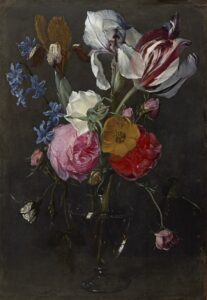Daniël Seghers: Flowers in a vase
At Museum Mayer van den Bergh: stay in the same room 2 Baroque painters
‘A bee came across his works,
and smell and colours,
and cried, “Nature, forgive me:
That flower paintbrush did deceive me.”
Joost van den Vondel wrote this poem in honour of the Phoenix of Flower Painters.
Still lifes, set tables, game and poultry: it’s a painting genre. Among the specialists who really restricted themselves to a single theme (and excelled at it) , we would like to introduce you to Daniël Seghers, the flowers painter. Born in Antwerp in 1590, he moved to Calvinist Utrecht with his widowed mother. But he returned to Antwerp in 1609, as a pupil of the ‘Velvet’ Brueghel. Shortly after he had become a member of the painters’ guild, he joined the Jesuit order.
This explains why much of his work is part of a larger programme, in line with the devotion to Mary or the saints is the central theme. The saints themselves are painted by colleagues, such as this Jan Brueghel the Elder or Hendrick van Balen, often in grisaille. These paintings by Seghers are also an ode to Creation: think of the Garden of Eden/Terrestrial Paradise. You will find his work in Antwerp in the collections of KMSKA and the Rubens House; there you ‘ll discover how his personal style has developed.
Seghers wreaths the saint with flowers or garlands, to which your eyes are drawn because of their meticulousness and beautiful colours. Painting ‘true-to-life/naer ‘t leven’ wasn’t just reserved for human beings as subjects. This collection here displays a simpler work: ‘Flowers in a Vase’. But it has all the distinctive qualities of the genre.
In those days art was never superficial; it tells a story and, certainly in the Catholic Counter-Reformation, its message is one of a religious morality. Very often the authenticity of the still-life is deceptive: depicted bouquets cannot be assembled in reality because they span the seasons. Not all the flowers should still be blooming: shortly after the peak, fading follows. A fragile butterfly represents the human soul; the wings help it to reach heaven.
And by the way, flowers like tulips, irises, roses were a luxury at that time, they were reserved for the well-to-do only.
As a painter, Seghers enjoyed a reputation that extended to the monarchs and the Dutch stadholders who were fond of his works and gave them away as presents to important relations.
Dutch writers like Vondel and Constantijn Huyghens dedicated poems to him. But he, as a lay brother or later as a priest, did not deviate from an austere lifestyle; he continued to live in the Antwerp Jesuits House (close to the St. Charles Borromeo Church). Before that, he had been developing his craftsmanship for two years in Rome. Daniel Seghers himself drew up a catalogue of all his works containing 239 references.
Continue along the Lange Gasthuisstraat33, the Maagdenhuis (Maiden’s House).

